The Transaction Control Transformation in Informatica allows you to control the Transactions within the Transformation. Using this transaction Control Transformation, you can Commit or Rollback the records (or rows) passing through it.
For this Informatica Transaction Control Transformation example, we are going to use SP Source and Destination tables.

Transaction Control Transformation in Informatica Example
In this example, we will show you how to use Transaction Control Transformation in Informatica to perform the Rollback Transaction. Before we start configuring, First, let me connect with the repository service.
To do so, we have to provide the Admin Console credentials. So, Please provide the appropriate Username and Password you specified while installing the Server.
TIP: We explained everything about the Transactions and its functionalities in the SQL Transaction article.
Source Definition for Transaction Control Transformation in Informatica
Once you connected successfully, Please navigate to Source Analyzer and define your Sources. In this Informatica Transaction Control Transformation example, we are using the Sp Source table from the SQL Server database as our source definitions. Please refer Database Source to understand the steps involved in creating Informatica source definition
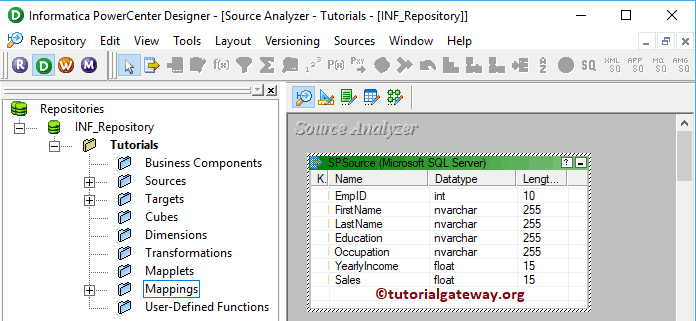
Create a Target Definition for Informatica Transaction Control Transformation
Please navigate to Target Designer to define the Target. In this example, we are using the existing SQL table (SP Destination) as our target definition. You can refer to Create Target Table to understand the process of creating a target definition

Create Mapping for Transaction Control Transformation in Informatica
To create a new mapping, Please navigate to the Mappings menu in Menu Bar and select the Create.. option.

Once you select the Create.. option, a new Mapping Name window will be opened. Let me provide m_Transaction as the mapping name and click OK button.
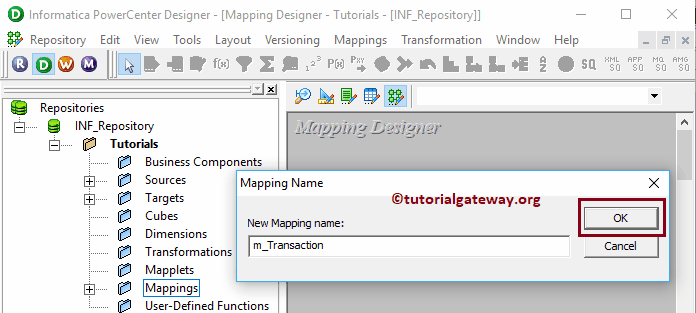
Drag and drop the SP Source from Sources folder to the mapping designer. Once you drag the source, Power Center Designer will automatically create the Source Qualifier Transformation (default transformation) for you.
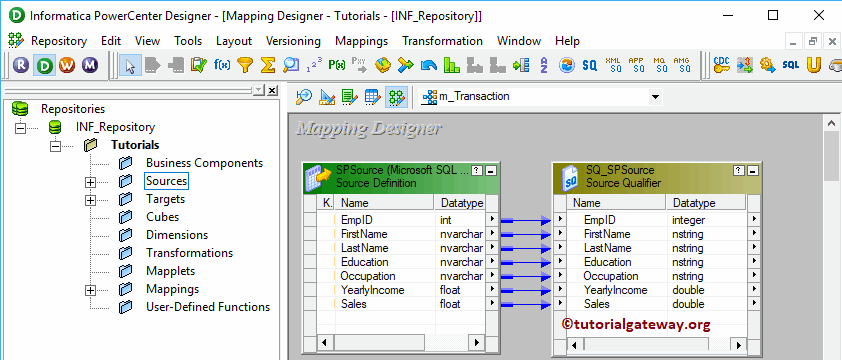
Create Informatica Transaction Control Transformation
To create Transaction Control Transformation in Informatica, Please navigate to the Transformation menu in Menu Bar. Next, select the Create.. option
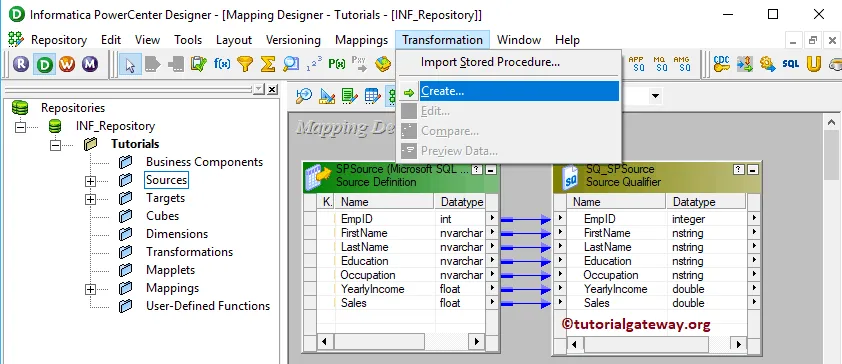
Selecting the Create.. option will open the Create Transformation window. Please select the Transaction Control Transformation from the drop-down list, and provide a unique name (Tran_Employee), and click on Create button
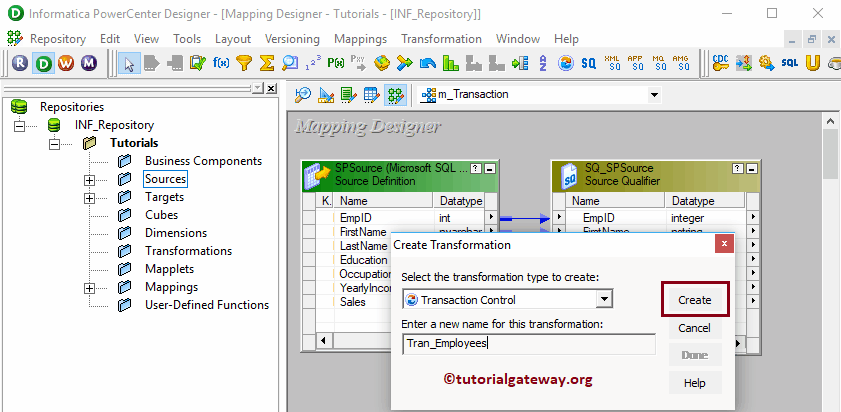
By clicking OK will create a Transaction Control Transformation for you.

Let me drag all the fields that are available in source definition to Transaction Control Transformation. Next, Drag and drop the target definition (SP Destination) from the Targets folder to the mapping designer. Lastly, connect the Transaction Control Transformation fields with the target definition using the Autolink.. option.

Double click on the Informatica Transaction Control Transformation to edit or configure the transformation. Please go to the Properties tab, and click on the Arrow beside the Transaction Control Condition to apply transactions at the mapping level.

Once you click the Arrow, an expression window will open. The Expression window in Transaction Control Transformation uses the IIF Function to test each row against the condition.
The Informatica Transaction Control Transformation provides the following built-in variables to apply transactions. For the demonstration purpose, let us take the above specified SP Source table and condition is EmpID = 5.
- TC_CONTINUE_TRANSACTION: This is the default value for this option. It does not perform any change for this row.
- TC_COMMIT_BEFORE: This is nothing but a Commit transaction in any relational database. If the condition is true, then it will first Commit the transaction. Next, it will begin a new transaction and writes the current row. Example: It will commit records up to EmpID 4 and start a new transaction to commit records from 5
- TC_COMMIT_AFTER: If the condition is true, then it will first write the current row and Commit the transaction. Next, it will begin a new transaction. Example: It will write and commit records up to EmpID 5 and begin a new transaction to commit records from 6
- TC_ROLLBACK_BEFORE: This is nothing a Rollback transaction in any relational database. If the condition is true, it will first Rollback the transaction. Next, it will begin a new transaction and writes the current row. Example: It will rollback records up to EmpID 4 and begin a new transaction to commit records from 5
- TC_ROLLBACK_AFTER: If the condition is true, it will first write the current row and then Rollback the transaction. Next, it will begin a new transaction. Example: It will rollback records up to EmpID 5 and begin a new transaction to commit records from 6
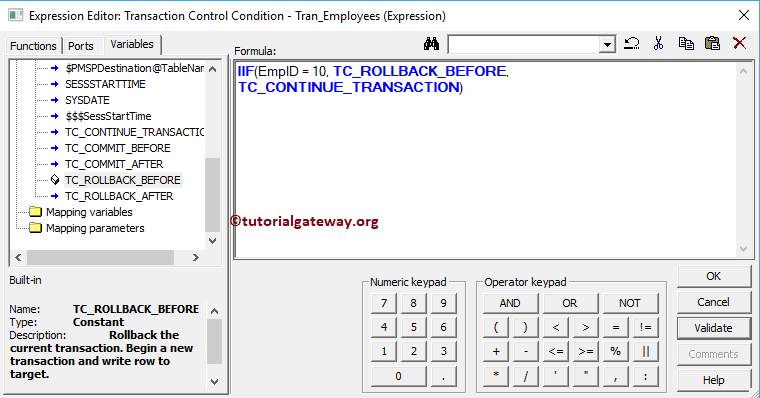
Click Apply and then click OK to close the Informatica Transaction Control Transformation window.

Before we close the Mapping, Let us Save, and Validate the mapping by going to Mapping Menu bar, and select the Validate option.
Create a Workflow for Transaction Control Transformation in Informatica
After you finish creating the Informatica Transaction Control Transformation Mapping, we have to create the Workflow for it. PowerCenter Workflow manager provides two approaches to create a workflow.
In this Informatica Transaction Control Transformation example, we will create the Workflow manually. To do so, Please navigate to Workflows Menu and select the Create option.

It will open the Create Workflow window. Please provide the unique name (wf_Transaction) and leave the default settings.

Once we created the workflow, our next step is to create a session task for our mapping.
Create a Session for Transaction Control Transformation in Informatica
There are two types of sessions:
For this Informatica Transaction Control Transformation example, we created a Non-reusable Session. To create Non-reusable Session, Please navigate to Tasks Menu and select the Create option as shown below.

Here, we are naming this session as s_Transaction. Once you click on the Create button, a new window called Mappings will open. Here, select the Mapping (m_Transaction) that you want to associate with this session.

Double click on the Session task will open the Edit Tasks window. Within the mappings tab, we have to configure the Source, Target Connections.
First, let us configure the source connections by clicking on the SQ_SPSource source present in the Sources folder. Within the Connections, click on the Arrow button beside the Relational type, and select the Database Object (Database Name) i.e., Source

Now, we have to configure the Target Connection. So, click on the SPDestination present in the Targets folder. Within the Connections, click on the Arrow button beside the Relational type, and select the Database Object (Target Database Name) i.e., target

Please change the Target Load Type to Normal or Bulk as per your requirements. Let me checkmark the Truncate target table option as well.
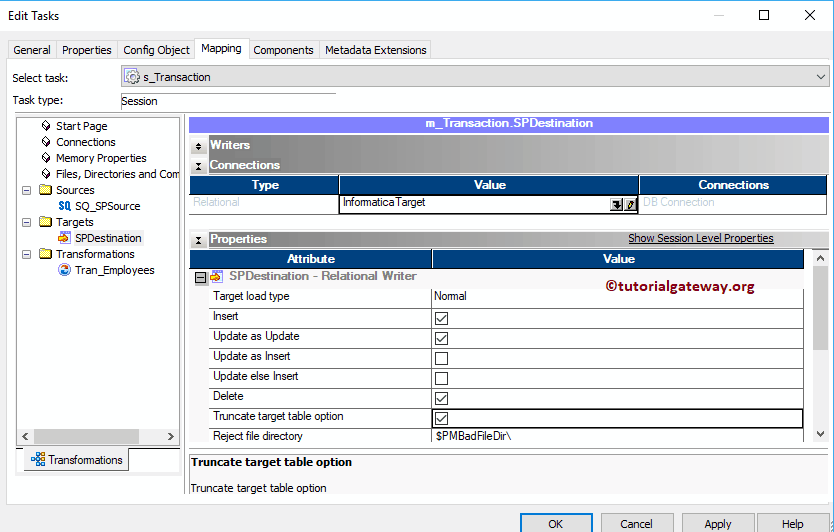
Next, navigate to Workflows Menu and select the Validate option to validate the Workflow.

Now, Let me start the Informatica Transaction Control Transformation Workflow. To do so, navigate to the Workflows menu and select the Start Workflow option.

Let us open the SQL Server Management Studio and write the following SQL Query to check whether we successfully transferred the data from a source or not. As you see that our target table is displaying records where EmpID = 10. Because Rollback will start before processing the record whose EmpID, is 10
This time we will use the TC_ROLLBACK_AFTER as the second argument in IIF. It means the Rollback option will perform after passing the EmpID 10.

As you can see, our target table is displaying records where EmpID is greater than 10


